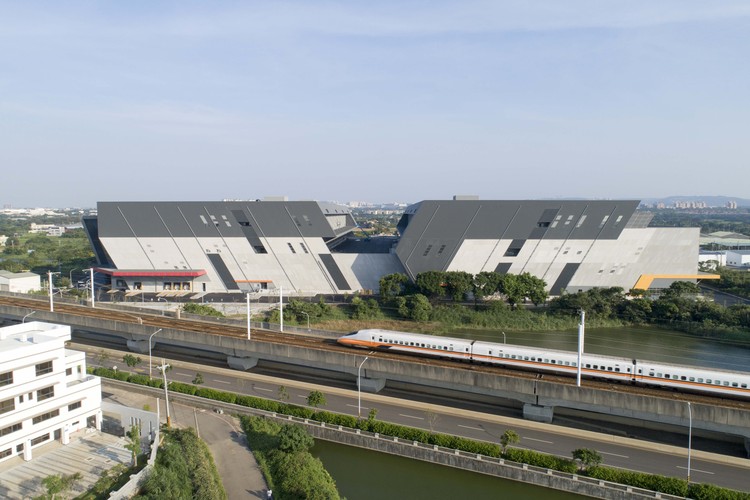Stadium du Littoral Olgga Architects
2011-11-01 00:00
架构师提供的文本描述。在2011年9月4日的盛大开幕式上,建造在格兰德同步的海滨体育场是巴黎北部第一个将五项运动项目合并在一个屋檐下的设施。由OLGGA建筑设计,这座运动场包括617个体育场座位,两个俱乐部的房子,更衣室,一个社区娱乐室和行政办公室。
Text description provided by the architects. Upon its Grand Opening September 4, 2011, the Stadium du Littoral, constructed in Grande Synthe, is the first facility north of Paris integrating five athletic disciplines under one roof. Designed by OLGGA Architectes, this athletic complex includes stadium seating for 617, two club houses, locker rooms, a community recreation room and administrative offices.
这座海滨体育场为该镇的4000名成员提供服务,还有三个橄榄球球场、两个足球场、一个射箭圈、一个跑道、一个1300米长的自行车圈,以及即将完工的小轮越野车(BMX)赛道。这座建筑建在巴斯克社区的12公顷土地上,确实是一座看得见的建筑灯塔,标志着进入城市的主要车辆(州际)入口。这个缩小的建筑与程序诱导的体积站在地平线上,这一天际线的阴影显示了无所不在的自然景观。
This Stadium du Littoral, provided for the town’s 4000 members, also has three rugby fields, two football fields, an archery round, a running track, a 1300m cycling ring, and soon-to-be-completed BMX track. Built on 12 hectares in the Basroch neighborhood, the building is indeed a visible architectural beacon, marking the major vehicular (interstate) entrance into the city. This pared-down building with program-induced volumes stands up against the horizon, this skyline of shadows reveals the omnipresent nature of the landscape.
该项目是从一个简单的平行四边形单体,响应客户制定的具体技术要求。这种紧凑的形式是“空洞化”在关键的地方,以容纳看台和俱乐部的房子。这些挖掘响应了在每一项运动中表现出的对高能见度的渴望。体育场不是单一的面向一个特定的领域,而是开放自己的所有运动员在他们的集体。
The project was elaborated from a simple parallelogram monolith, responsive to the specific technical requirements established by the client. This compact form is “hollowed out” in key places to accommodate bleachers and club houses. These excavations respond to the desire for high-visibility manifest in each sport. The stadium is not mono oriented toward a specific field, rather it opens itself onto all athletics in their collective.
基地,屋顶和被覆盖的露台形成一个单一的,统一的实体。材料的选择比较柔和,其固有的特性保证了结构的耐久性和易维护性。体育馆的底部是密封的混凝土,里面有集体橄榄球和足球设施,以及行政办公室、桑拿和举重室。海豹的卫星外观创造了一个不断变化的外观,这取决于太阳光的数量。
The base, the roof and the covered terrace form a single, unified entity. The subdued choice of materials, and their inherent characteristics guarantee the durability of the structures and ease of maintenance. The base of the Stadium, in sealed concrete, houses the collective rugby and soccer facilities as well as administrative offices, sauna and weightlifting rooms. The satiny appearance of the seal creates an ever-changing appearance, depending on the amount of sunlight.
在较高的层次上,空洞化的成分是较浅的颜色.橄榄球俱乐部和自行车俱乐部位于中间.这些玻璃盒子充分利用了现场的全景景观。俱乐部的定义是一个双层皮肤系统,由玻璃面板,间隙空间和拉伸安装的微穿孔织物组成。除了提供最佳的热控制外,这种分层过滤系统还允许观众在不被从比赛场地看到的情况下观看比赛。
On the upper level, the hollowed-out components are of a lighter color. The rugby and cycling clubhouses are situated in-between. These glass boxes take advantage of panoramic views of the site. The clubhouses are defined by a double skin system, composed of glass panels, interstitial space and stretch-mounted micro-perforated fabrics. In addition to providing optimal thermal control, this layered filter system also allows spectators to take in an event without being seen from the playing field.
这些会所为会员提供隐私和舒适的观众席,是娱乐和讨论的理想场所。
With privacy and comfortable spectatorship for club members, these club houses are ideal places for conviviality and discussion.
在这两个方案元素之间,一个宽敞的有盖的露台提供了一个鼓舞人心的景点景观。这个空间没有结构约束。承重结构,巧妙地隐藏在帆布后面,将后座移至事件帆布的简单图形纯度。金属上层建筑悬空,允许光线和空气穿透。露台是每个人的公共空间。
Between these two programmatic elements, a spacious covered terrace offers an inspiring view of the site. The space is devoid of structural constraints. The load-bearing structure, cleverly hidden behind the canvas, takes the backseat to the simple graphic purity of the event-canvas. The metal superstructure hovers and allows light and air to penetrate. The terrace is a communal space for everyone.
这个露台可以从看台直接到达,也可以通过悬臂式的人行桥到达场地的北面。这个免费的接入点允许公众进入大楼,而不会干扰正在进行的自行车比赛。
This terrace is accessible directly from the stands or via the pedestrian bridge that cantilevers the track to the north of the site. This complimentary access point allows the public to enter the building without disturbing cycling competition under-way.
看台坐落在较浅颜色的挖掘部分,赋予整体一种独特的优雅。
The stands are nestled in the lighter-colored excavated portion, bestowing the ensemble with a singular elegance.
我们自己的可持续性战略与客户对生态的尊重相结合,最终形成了一座处于环境责任最前沿的建筑。滨海体育场实现了显著的节能。建筑符合严格的THPE 2005标准(Eq)。LEED-节能设计的领导),体育场是由耐用的材料建成的。加强绝缘,两个热泵和交替流动通风系统避免热损失。内部采用低排放照明。
Our own strategies of sustainability combined with the client’s respect for ecology, culminated in a building that is at the forefront of environmental responsibility. The Stadium du Littoral realizes significant energy savings. Built to the stringent THPE 2005 standards (eq. LEED – Leadership in Energy Efficient Design), the stadium is made of durable materials. Reinforced insulation, two heat pumps and an alternate flow ventilation system avoid heat loss. The interior utilizes low emission lighting.
安装在屋顶上的700平方米光伏电池板产生的电能被卖回电网。这一战略可大幅度减少业务费用。此外,40平方米的太阳能电池板覆盖50%的热水能源需求。
700 sqm of photovoltaic panels built into the roof produce electricity sold back to the grid. This strategy allows for a significant reduction in operating costs. Additionally, 40 sqm of solar panels cover 50% of hot water energy requirements.
该能源生产系统将很快完成安装风力涡轮机的北部地区。大球场亦设有雨水储存系统。一个容量为8m3的蓄水池为厕所和清洁提供水。
The system for energy production will soon be completed by the installation of a wind turbine to the north of the site. The Stadium is also equipped with a rainwater storage system. A cistern of 8 m3 capacity provides water for toilets and cleaning.
在全面建设的时候,滨海体育场将成为公共项目中碳排放的领先者,这些项目产生的能源比消耗的要多。
At full build-out, the Stadium Littoral will become a carbon positive leader in the family of public projects that produce more energy than they consume.
Text provided by OLGGA Architects
 举报
举报
别默默的看了,快登录帮我评论一下吧!:)
注册
登录
更多评论
相关文章
-

描边风设计中,最容易犯的8种问题分析
2018年走过了四分之一,LOGO设计趋势也清晰了LOGO设计
-

描边风设计中,最容易犯的8种问题分析
2018年走过了四分之一,LOGO设计趋势也清晰了LOGO设计
-

描边风设计中,最容易犯的8种问题分析
2018年走过了四分之一,LOGO设计趋势也清晰了LOGO设计




























































































































